|






Click the flag
Meet our special
U.S. Publishers
|
Sensory
Resources (Including Sensorimotor, Movement & Self-Regulatory Titles)
Featured
Books in this Category
Back
to Autism Spectrum Disorders Booklists

Featured
Books
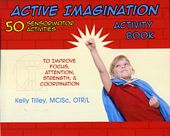
|
Active Imagination Activity Book. Kelly Tilley, $23.95
50 sensorimotor activities to improve focus, attention, strength and coordination. |
|
Answers to Questions Teachers Ask About Sensory
Integration: Forms, Checklists and Practical Tools. Carol Kranowitz et al,
$20.50
In this elegant approach to the often-elusive subject of
sensory integration, Carol Kranowitz and expert occupational therapists have
assembled an extensive and easy-to-use set of checklists and other tools that
will be invaluable to every teacher (and parent) who has children with sensory
processing challenges. You’ll find tried-and-true instructions for developing
fine-motor, “organizing,” and motor-planning skills, and for providing an
appropriate “Sensory Diet” that will benefit all your students. Checklists help
you identify students who have difficulty processing sensory information. With
up to 20% of the students in any given classroom affected by Sensory Processing
Disorder, Answers to Questions is an invaluable resource for teachers of
preschool through high school. |
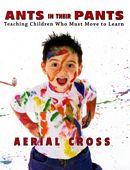
|
Ants in Their
Pants: Teaching Children Who Must Move to Learn. Aerial Cross,
$41.50
Extra busy children — children
who must move to learn — demand non-traditional
environments and teaching methods. By focusing on the kinesthetic
nature of these children this practical, hands-on resource
is filled with transition ideas, sensory-play activities, advice
and inspiration for teachers, caregivers and parents. |
Back to top
|
Arnie and His School Tools: Simple Sensory
Solutions That Build Success. Jennifer Veenendall, $25.95
Arnie and His School Tools
is an illustrated children's book about an exuberant little boy
who had difficulty paying attention in class and doing his school
work until he was equipped with the tools to accommodate his sensory
needs. Written from Arnie's point of view, the book uses simple
language to describe some of the sensory tools and strategies he
uses at school and home to help him achieve a more optimal level
of alertness and performance. Occupational therapists, teachers
and parents will find this book an engaging way to introduce elementary
students to basic sensory tools used to help children focus in classroom
settings, such as fidgets, chewy pencil toppers, and weighted vests.
Additional resources are provided at the end of the book, including
definitions of sensory processing and sensory modulation disorder,
suggested discussion questions, and lists of related books and websites.
|
|
ASANAS for Autism and Special Needs: Yoga to Help
Children with Their Emotions, Self-Regulation and Body Awareness. Shawnee
Thornton Hardy, $19.95
This how-to handbook gives parents, teachers, and yoga
instructors step-by-step instruction to teach yoga poses to a child with autism
or other special needs. They will learn how to teach yoga in a fun and
interactive way using games and activities with numerous benefits to the child
from teaching body parts to emotional and sensory regulation.
Breaking down yoga instruction pose by pose, body part by
body part, breath by breath, this book uses easy-to-understand language and
clear photographs to show parents, teachers, yoga instructors, and other
professionals how to introduce the life-long benefits of yoga to a child with
special needs. These benefits include gaining greater awareness and
understanding of the body, learning to self-regulate the nervous system, and
developing coping skills to work through difficult emotions such as anger and
anxiety. Creative yoga games, activities, relaxation exercises, and chair yoga
poses are included to make learning yoga a fun, interactive, and calming
experience for children with a wide range of abilities. |
|
The ASD and Me Picture Book: a Visual Guide to
Understanding Challenges and Strengths for Children On the Autism Spectrum.
Joel Shaul, $27.95
Children with ASDs often find it difficult to identify
the things they find difficult and, more importantly, to recognize the things
they are good at. This colorful book provides simple self-exploration tools to
help children identify their strengths and begin to tackle the things they find
harder.
The book explores a range of common difficulties,
including communication, emotional and sensory regulation, and executive
functioning, encouraging children to explore their personal challenges and
abilities in an engaging and positive way. Illustrated with hundreds of
cartoon-style graphics and containing a wealth of fun tools, games, activities
and photocopiable worksheets, this book is ideal for children with ASDs aged
7-14, and will be equally useful at home or in the classroom. |
Back to top
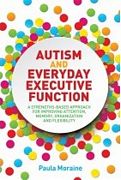
|
Autism and Everyday Executive Function: a
Strengths-Based Approach for Improving Attention, Memory, Organization, and
Flexibility. Paula Moraine, $30.95
Understand and support executive function in individuals
with Autism Spectrum Disorder (ASD) with this fully-explained, innovative
model. Showing how to use an individual's strengths to address executive
functioning weaknesses, this approach will also help to build a strong
foundation for social and communication skills.
Advocating a person-centred approach, the author describes the importance of
identifying the individual's preferred style of engagement and communication,
and how sensory experiences impact their thoughts, feelings, and actions. She
explains how to use this information to identify the individual's strengths and
weaknesses across eight key areas which are the building blocks of executive
functions: attention; memory; organization; time management; initiative;
behavior; goal setting and flexibility. These areas can be used daily to
establish predictability and offer a foundation for interpreting, processing and
understanding the world with flexibility. Professionals and parents can also
use them as the basis of an Individualized Education Plan (IEP), or to create
personalized interventions and support at school or at home. |
|
Autism and the Stress Effect: a 4-Step Lifestyle
Approach to Transform Your Child's Health, Happiness and Vitality. Theresa
Hamlin, $22.95
Presenting a revolutionary lifestyle approach for the
whole family, this step-by-step guide will help you to reduce your child's
stress and anxiety levels by regulating their environment, eating and
nutrition, energy, and encouraging emotional self-regulation.
Children with autism often experience very high stress levels in learning and
social environments, which can exacerbate problem behaviors and damage their
physical and emotional health. This book demonstrates that lowering stress
levels through regulating a child's experiences and environments, and giving
them the tools to cope when stressful situations are unavoidable, can make a
huge and very positive difference to their behavior, physical health,
socialisation and happiness. Brimming with exercises, recipes, tips and
real-life examples, this warm and supportive guide will help you transform the
life of your child with autism and benefit the whole family. |
|
A Buffet of
Sensory Interventions: Solutions for Middle and High School Students
with Autism Spectrum Disorders. Susan Culp, $28.00
Teaching teens with ASDs to take ownership of their sensory needs by self-advocating and self-regulating is vital as they transition into adulthood. This well-organized, accessible book does just that. Using examples of everyday challenges and proactive strategies for self-regulation, author Susan Culp serves up a fantastic buffet of ways to help sensory-challenged students survive the school environment. |
Back to top
|
Building Bridges through Sensory Integration: Therapy
for Children with Autism and Other Pervasive Developmental Disorders, 3rd
Edition. Paula Aquilla, Shirley Sutton & Ellen Yack, $38.50
Written by three experienced occupational therapists,
this book offers a combination of theory and strategies. It is a perfect tool
for those working with young children, but also broad enough to be adapted for
older children and adults. Building Bridges provides creative techniques
and useful tips while offering innovative strategies and practical advice for
dealing with everyday challenges, including managing behaviors, improving
muscle tone, developing social skills, selecting diets, and more. Part one explains
the role of the occupational therapists in treatment and examines sensory
integration theories. Part two offers methods of identifying sensory problems
in children along with numerous strategies and activities. Helpful topics
include:
- What is Occupational Therapy?
- What is Sensory Integration?
- What are the Sensory Systems?
- Identifying Problems with Sensory Integration Strategies for
Challenging Behaviors
- Ideas for Self Care Skills
- Adapting Home, School, and Child Care Settings
|
|
Building Sensory
Friendly Classrooms to Support Children with Challenging Behaviors. Rebecca Moyes, $28.00
Sensory Integration Disorder often manifests as a behavioral problem. This book shows teachers how to incorporate data-driven strategies in designing a classroom that both minimizes stress and improves student productivity. |
|
Can I Tell You about Sensory Processing Difficulties?
A Guide for Friends, Family, and Professionals. Sue Allen, $15.95
Harry explains what happens when the sensory information
that we all process throughout the day does not transmit smoothly and leads to
challenges in learning, movement or behaviour. He talks about how he can be
helped at home and at school and the different types of sensory processing
challenges that other children can face. |
Back to top
|
Can't Play Won't
Play: Simply Sizzling Ideas to Get the Ball Rolling for Children
with Dyspraxia. Sharon Drew & Elizabeth Atter, $27.95
Learning to roller skate or ride a bike
should be an enjoyable experience, but for a child with developmental
co-ordination disorder (DCD, also known as dyspraxia), these activities
can lead to frustration and failure. Can't Play Won't Play is full of practical information, tips and hints to enable children
with DCD to access and enjoy activities that other children take
for granted. |
|
Color My Senses: the Sensory Detective Coloring Book. Paula
Aquila, $13.50
Color My Senses is an insightful way to teach kids
about our amazing sensory system. |
|
Cool Bananas: Favorite
Kids’ Rhythms for Calming, Cool Downs and Bedtime Routines.
Genevieve Jereb, $29.95
Enchanting favorite children’s
songs sung at 50 to 70 bpm (beats per minute) to support the
dysregulated child during playtime, bath time, car rides and
other unstructured intervals. These soothing rhythms and songs
can also be used for quiet times or quiet therapies and bedtime
routines. |
Back to top
|
Creating Multi-sensory
Environments: Practical Ideas for Teaching and Learning. Christopher
Davies, $42.50
Multi-sensory environments in the
classroom provide a wealth of stimulating learning experiences for all young
children whose senses are still under development. CREATING MULTISENSORY
ENVIRONMENTS is a highly practical guide to low-cost, easy to assemble
multi-sensory environments. With a step-by-step guide to each activity, these
creative learning environments focus on multi-sensory experiences and are
designed to stimulate all the sensory channels — auditory, visual, kinesthetic,
olfactory and gustatory.
Theory and background to multi-sensory
learning is provided to enable you to adapt the suggested scenarios according
to the needs of individual learners. This practical and easy to use book is an
essential companion for busy classroom practitioners wanting to create a
stimulating and meaningful learning environment. |
|
Developmental Coordination Disorder: Hints and Tips
for the Activities of Daily Living. Morven Ball, $25.95
Developmental Coordination Disorder (DCD) is a term used
to describe children who have difficulty with movement and specific aspects of
learning, and includes dyspraxia, Asperger Syndrome and associated conditions.
This easy-to-read booklet answers commonly asked questions about DCD and
presents all the necessary information to aid parents, carers and professionals
in selecting the best options for their child; sometimes correcting the little
things can lead to big results.
In clearly laid out chapters, the author describes the
features of Developmental Coordination Disorder and provides practical
solutions ranging from maintaining posture and personal care through to the
more complex tasks of learning. Practical exercises to help improve the DCD
child's motor and sensory skills are included, plus an extensive list of useful
addresses and resources. |
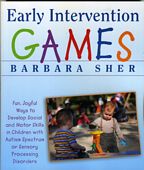
|
Early
Intervention Games. Barbara
Sher, $19.95
A resource of fun games for parents
or teachers to help young children learn social and motor skills.
Barbara Sher, an expert occupational
therapist and teacher, has written a handy resource filled with
games to play with young children who have Autistic Spectrum
Disorder (ASD) or other sensory processing disorders (SPD). The
games are designed to help children feel comfortable in social
situations and teach other basic lessons including beginning
and end, spatial relationships, hand-eye coordination, and more.
Games can also be used in regular classrooms to encourage inclusion
and all the games utilize common, inexpensive materials, and
include several variations and modifications. |
Back to top
|
Ellie Bean
the Drama Queen. Jennie Harding, illustrated by David Padgett,
$13.50
This is the story of Ellie and what it’s like to have sensory issues — and of how Ellie learned to keep calm and not overreact! |
|
Eurhythmics for Autism and Other Neurophysiologic
Diagnoses: a Sensorimotor Music-Based Treatment Approach. Dorita Berger,
$35.95
The theory and practice of incorporating Eurhythmics movement
in music-based sessions. Session plans and case studies are included to
illustrate how the treatment can be used with a range of cognitive and sensory
issues, such as autism, dementia, PTSD, stroke, and cerebral palsy.
Covering both theory and practice, she explains this
innovative, music-based approach and how it can also address cognitive and
sensory issues in adults with debilitating conditions, such as dementia or
post-traumatic stress disorder. With a particular emphasis on autism, she
provides clear and adaptable session plans, suitable for working with children
and adults of all ages. |
|
Everyday Games for
Sensory Processing Disorder: 100 Playful Activities to Empower Children with
Sensory Differences. Barbara Sher, $22.95 (for children ages 1-12)
If you’re looking for new strategies to manage your
child's sensory processing disorder, Everyday
Games for Sensory Processing Disorder advocates play as the most effective
approach for children with SPD, and illustrates the many ways that play can
lead to significant breakthroughs, including:
- 100 fun and simple games for parents to play
with their kids
- An easy-to-grasp overview of sensory processing
disorder
- Inventive ideas for engaging kids, using
materials easily found around the house
- Inclusive games geared toward varying degrees of
development, with modifications for older children
|
Back to top
|
Getting Kids in Sync DVD: Sensory-Motor Activities to
Help Children Develop Body Awareness and Integrate Their Senses. Carol
Kranowitz, $21.95 (29 minutes)
Carol Kranowitz demonstrates many SAFE (Sensory-motor,
Appropriate, Fun and Easy) activities on this 30-minute video, with the help of
the preschool students of St. Columba’s Nursery School in Washington, DC. The
activities help children of differing abilities to develop their skills and
integrate their senses. The activities are ideal to use at home or school.
Some of the music and movement activities included on the
video are Paper Plate Dance, Plate Skate, Stretchy Bands, and T-Stools.
Watching groups of children participating in the activities helps parents,
teachers, and kids imitate and expand on the action when they try the
activities. For those adults who appreciate written directions, the activities
are described at length in The Out-of-Sync Child Has Fun. |
|
The Goodenoughs Get
In Sync. Carol Stock Kranowitz, $16.95 (ages 8-12)
The Goodenoughs will charm you with their story about the tough
day... when the whole family ended up in the doghouse! This
introduction to Sensory Processing Disorder, suitable for eight-to-twelve-year-olds,
will help them understand how their senses develop, how to get in
sync, and how to appreciate differences.
The book is designed with the action of the story in larger print
for younger readers to read or hear. Explanations of sensory processing
disorder are woven through the story in regular type for proficient
readers to linger over at leisure. |
|
Growing an In-Sync
Child: Simple, Fun Activities to Help Every Child Develop, Learn
and Grow. Cartol Kranowitz & Joye Newman, $20.00
A fresh and timely approach to understanding the profound impact of motor development on children of all ages and stages, Growing an In-Sync Child provides parents, teachers, and other professionals with the tools to give every child a head start.
Because early motor development is one of the most important factors in a child's physical, emotional, academic, and overall success, the In-Sync Program of sixty adaptable, easy, and fun activities will enhance your child's development, in just minutes a day. Discover how simple movements such as skipping, rolling, balancing, and jumping can make a world of difference for your child — a difference that will last a lifetime. |
Back to top
|
A Guide to Sometimes Noise Is Big for Parents and
Educators. Angela Coelho & Lori Seeley, $19.95
Understand how children with autism experience the world
around them with this simple guide. Learn why they might react unexpectedly to
lights, noise, and even seemingly simple requests, and what you can do to help
reduce sensory overload.
This accompanying guide to the children's picture book Sometimes
Noise is Big takes the illustrations and gives a breakdown of what is
happening in each picture, with practical tips on how to help children who
struggle with sensory issues. This book can also be used as a standalone
resource, and is ideal for supporting children aged 5+ with autism at home, in
the classroom, and for raising awareness of autism and sensory issues.
Also available: Sometimes Noise Is Big. Angela
Coelho & Camille Robertson, $21.95 (ages 5+) |
|
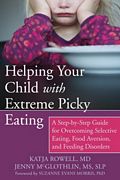
|
Helping Your Child with Extreme Picky Eating: a
Step-by-Step Guide for Overcoming Selective Eating, Food Aversion, and Feeding
Disorders. Katja Rowell & Jenny McGlothlin, $24.95
In Helping Your Child with Extreme Picky Eating,
a family doctor specializing in childhood feeding joins forces with a speech
pathologist to help you support your child's nutrition, healthy growth, and end
meal-time anxiety (for your child and you) once and for all.
Are you parenting a child with 'extreme' picky eating? Do
you worry your child isn't getting the nutrition he or she needs? Are you tired
of fighting over food, suspect that what you've tried may be making things
worse, but don't know how to help? Having a child with 'extreme' picky eating
is frustrating and sometimes scary. Children with feeding disorders, food
aversions, or selective eating often experience anxiety around food, and the
power struggles can negatively impact your relationship with your child.
Children with extreme picky eating can also miss out on parties or camp because
they can't find “safe” foods. But you don't have to choose between fighting
over every bite and only serving a handful of safe foods for years on end.
Helping Your Child with Extreme Picky Eating offers
hope, even if your child has “failed” feeding therapies before. After gaining a
foundation of understanding of your child's challenges and the dynamics at
play, you'll be ready for the five steps (built around the clinically proven
STEPS+ approach-Supportive Treatment of Eating in PartnershipS) that transform
feeding and meals so your child can learn to enjoy a variety of foods in the
right amounts for healthy growth. You'll discover specific strategies for
dealing with anxiety, low appetite, sensory challenges, autism spectrum-related
feeding issues, oral motor delay, and medically-based feeding problems. Tips
and exercises reinforce what you've learned, and dozens of “scripts” help you
respond to your child in the heat of the moment, as well as to others in your
child's life (grandparents or your child's teacher) as you help them support
your family on this journey. This book will prove an invaluable guide to
restore peace to your dinner table and help you raise a healthy eater. |
Back to top
|
How Does Your Engine Run? A Leader’s Guide to the
Alert Program for Self-Regulation. Mary Sue Williams & Sherry
Shellenberger, $60.95 (booklet, $13.95)
The Leader's Guide contains everything needed to
implement the Alert Program®: it explains the theory, along with step-by-step
instructions and easy-to-implement activities. It was written to teach children
how to identify and change how alert they feel, initially using the analogy of
an engine. If a child is non-verbal or has special interests (such as a love of
dinosaurs), instead of using the engine analogy, the program can be customized
and easily adapted. With its three stages and 12 “mile marker” steps, this
evidence-based practice approach is ideal for those who have attention
problems, autism, developmental delays, and/or other learning challenges.
The Alert Program® consists of a series of lessons and
activities, that when incorporated with sensory processing techniques, has
proven to be highly effective. The program has been adapted successfully for
preschool through high school students and for adults. |
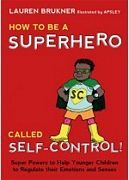
|
How to Be a Superhero Called Self-Control: Super
Powers to Help Younger Children to Regulate Their Emotions and Senses. Lauren Brukner, illustrated by Apsley, $22.95
Meet Self-Control, a superhero who wants to teach young
children his super powers of self-control! Anxiety, frustration, anger, and
other difficult feelings won't stand a chance against their new-found powers. Self-Control
teaches children with emotional and sensory regulation difficulties aged
approximately 4-7 how to calm themselves using self-massage, deep pressure,
breathing exercises, and activities such as making an imaginary list and
finding their own peaceful place. This illustrated book also features an
appendix with photocopiable super power charts, reinforcers, and reminder tools
to ensure that parents, teachers, and other professionals can support children
in upholding superhero strategies even after the book has been read. |
|
|
How to Help a Clumsy Child: Strategies for Young
Children with Developmental Motor Concerns. Lisa Kurtz, $15.95
When a child has a developmental delay affecting motor
coordination and development the ramifications are far reaching, from the daily
tasks of dressing and brushing your teeth, to learning to write and
participating in sports. How to Help a Clumsy Child is a practical
resource manual and 'how to help' book for parents of, or professionals working
with, young children with motor coordination developmental delays. It covers a
range of topics, including recognizing normal and abnormal motor development,
when and how to seek help, an overview of approaches used to help the clumsy
child, and specific teaching strategies appropriate for both parents and
professional caregivers.
Rather than focusing upon one specific frame of
reference, Lisa Kurtz offers a diverse range of ways to manage motor coordination
and development problems, and also discusses the controversial nature of
therapy for these children. Multiple tables and lists serve as quick reference
guides and the three appendices include extensive further reading and an
invaluable contacts list, making this an essential resource for anyone caring
for, or working with, children with developmental motor concerns. |
Back to top
|
I'll Tell You Why I Can't Wear Those Clothes! Talking about
Tactile Defensiveness. Noreen O'Sullivan, $17.95
Do you know a child who hates the feel of certain items
of clothing? This book is a child's perspective on a largely unrecognized
condition called tactile defensiveness, a physical condition that causes
hypersensitivity to certain touch sensations. Intended for adults and children
to read together, the illustrated book explains reasons a child may become
emotionally overwhelmed by daily routines such as putting on clothing, socks
and shoes. The workbook format allows children to express and explore their own
feelings through drawings or words, in order to explain their misunderstood
behavior.
A perfect book for children, families, teachers,
therapists and other professionals dealing with tactile defensiveness suitable
to be read with children aged four and above. |
|
Improving Sensory Processing in Traumatized Children:
Practical Ideas to Help Your Child's Movement, Coordination, and Body
Awareness. Sarah Lloyd, $19.95
Early trauma and neglect can have a profound effect upon
a child's development. Sensory integration theory offers a way of understanding
how the brain processes and stores movement experience, and how these
experiences manifest at a physical and emotional level. This book explains how
early movement experiences affect brain development and gives examples of how
trauma can prevent basic sensory processing pathways from being correctly
established. It shows how you can identify gaps in normal sensory development
and offers ideas for how you can use physical activities to help build up the
underdeveloped systems. Good bodily awareness forms the foundation of motor
development as well as social and emotional skills and learning. This book will
help your child to be more in tune with themselves and their bodies and feel
more comfortable in their environment.
Highly accessible with lots of practical tips and
examples, this book is written for adoptive and foster parents, and will also
be useful for social workers, fostering and adoption workers and those working
in primary and early years educational settings. |
|
Insights into
Sensory Issues: Answers to Sensory Challenges. Kathleen
Morris, $21.50
A collection of articles from the outstanding magazine on sensory integration, S.I. Focus. |
Back to top
|
|
The In-Sync Activity Card Book: 50 Simple Activities
to Help Children Develop, Learn, and Grow! Joye Newman & Carol Kranowitz,
$27.95
These two experienced authors have over seventy
combined years of teaching experience, and now share their experience and ideas.
Using these handy cards, parents and teachers can help kids grow, learn, and
develop to the best of their abilities!
Divided into beginner, intermediate, and advanced, each
card tells you why and how the activity works, what props you may need, and
ways to make it more challenging. It also tells you what to look for, to
make sure a child is getting the most out of the activity. |
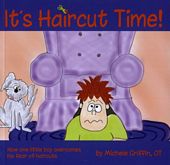
|
It's Haircut Time! Michele Griffin, $13.95
How one little boy overcomes his fear of
haircuts. |

|
Jumpin’ Jelly
Beans. Gen Jereb & Friends, $23.95 CD
Using the principles of sensory processing
theory, Gen Jereb creates fun, engaging and ready-to-roll music
and rhythmic activities for children with attention, motor
and regulation difficulties. |
Back to top
|
The Kids' Guide to Staying Awesome and In Control: Simple
Stuff to Help Children Regulate their Emotions and Senses. Lauren Brukner, Illustrated
by Apsley, $25.95
Packed with simple ideas to regulate the emotions and
senses, this book will help children tackle difficult feelings head-on and feel
awesome and in control! From breathing exercises, pressure holds and finger
pulls, to fidgets, noise-reducing headphones and gum, the book is brimming with
fun stuff to help kids feel cool, calm and collected. They will learn how to
label difficult feelings, choose the perfect strategies and tools to tackle
them, and use these correctly whether at home or at school. The strategies and
tools are accompanied by cartoon-style illustrations, and the author includes
useful tips for parents and teachers as well as handy visual charts and
checklists to track learning and progress.
Armed with this book, kids will be well on their way to
managing difficult emotions and feeling just right in whatever situation life
throws at them! Suitable for children with emotional and sensory processing
difficulties aged approximately 7 to 14 years. |
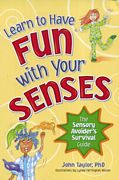
|
Learn to Have Fun with Your Senses: the Sensory Avoider’s Survival Guide. John Taylor, $20.95
This concise and easy-to-read book will help kids of all ages learn to stop overreacting and overcome their sensory problems. This useful guide includes information for parents, teachers and OTs working with kids who are sensory defensive. |
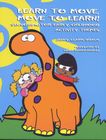
|
Learn to Move, Move to Learn!
Sensorimotor Early Childhood Activity Themes. Jenny
Clark Brack, $48.50; DVD $37.95
Jam-packed with creative theme-based
group lessons, this resource follows a sensory integrated developmental
sequence consisting of seven activities related to the theme. For maximum
flexibility, suggestions for adaptation and modification for individual
students are included, along with instructions for how to develop additional
lessons. The companion DVD, Learn to Move, Move to Learn:
Dinosaurs, gives a first-hand view of real children engaged in a dinosaur
theme-based sensorimotor lesson and thus sparks ideas for other similar
activities. |
Back to top
|
Learning in Motion:
101+ Sensory Activities for the Classroom. Patricia Angermeier,
Joan Krzyzanowski & Kristina Keller Moir, $53.95
Ideal for preschool, kindergarten and primary classes, each
of the 101+ activities in Learning in Motion has been
developed to attract and keep children’s interest by using
a multi-sensory approach in order to improve each child’s
learning and behavior. Activities are organized by month so educators
can quickly choose activities that correspond with seasons, holidays
and educational goals throughout the year. |
|
|
Learning Though Movement and Active Play in the Early
Years: a Practical Resource for Professionals and Teachers. Tania Swift,
$29.95
In this practical resource, Tania Swift provides early
years professionals with a wealth of creative ideas for supporting children's
wellbeing and development through physical activity.
Drawing on the author's wealth of training experience,
each chapter sets out a range of knowledge development, tips, tools and
activities that teachers and practitioners can use to support and enhance
children's learning and development and examples of good practice from other
practitioners and teachers. The book explores personal, social and emotional
development; mathematics and numeracy; literacy, language and communication;
knowledge and understanding of the world; expressive arts, design and creative
development; and spiritual, moral, social and cultural development.
Full of creative ideas that early years workers and
teachers can easily implement, this book will equip readers with the knowledge
and confidence to plan for effective learning through movement and active play.
Ideal for practitioners working with children aged 3-7 years. |
|
The Littlest
Inventor. Mandi Mathis, $16.95
The Littlest Inventor is a
brilliantly colored picture book featuring a smart, sensitive boy with sensory
issues. These issues make it challenging to experience something most of us
have no problem with, like a simple trip to the grocery store. But, by being
both self-aware and proactive, the Littlest Inventor can help himself succeed
in the very task he finds most difficult. He invents his own resources and
tools to make the trip fun!
For those with sensory processing disorder, life can
often be overwhelming. But, when equipped with knowledge to help ourselves and
confidence to be ourselves, life becomes not just manageable, but enjoyable. |
Back to top
|
Living Sensationally:
Understanding Your Senses. Winnie Dunn, $24.95
How do you feel when you bite into a
pear… wear a feather boa… stand in a noisy auditorium… or look for
a friend in a crowd?
It's likely that one of these situations
would be pleasant for you and perhaps one would be unpleasant. Some
people will adore the grainy texture of a pear, while others will
shudder at the idea of this texture in their mouths. Touching a
feather boa will be fun and luxurious to some, and others will bristle
at the idea of all those feathers brushing on the skin. Noisy, busy
environments will energize some people, and will overwhelm others.
These different reactions reflect people's
individual sensory patterns, which in turn affect the way we react
to everything that happens to us throughout the day. Living
Sensationally identifies four major sensory types: Seekers,
Bystanders, Avoiders and Sensors. The author helps readers to find
their own patterns and the patterns of those around them, and then
offers suggestions for harnessing this knowledge to make their lives
more in synch with their sensations.
Living Sensationally provides
practical sensory ideas for individuals, families and businesses.
Armed with the information in Living Sensationally, people
will be able to pick just the right kind of clothing, job and home
and know why they are making such choices. |
|
Making Sense
of Your Senses: a Workbook for Children with Sensory Processing
Disorder. Judy Christopher Auer & Michelle Auer, $23.95
Help your child to overcome sensory overload — one activity at a time.
These 40 simple, fun activities teach kids to integrate their senses, develop coordination, and to practice self-calming skills. These techniques can be used anytime they feel overwhelmed or have the urge to seek out intense sensory experiences. Before long, your child will be better able to tolerate everyday sensations and prevent simulation overload.
|
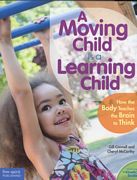
|
A Moving Child Is a Learning Child: How
the Body Teaches the Brain to Think: Gill Connell, Cheryl
McCarthy, $50.990 (Birth to Age 7)
Just as kids’ bodies need specific
nutrients for good health, they also need a balanced diet of physical activity
to help them reach their potential. Authors Gill Connell and Cheryl
McCarthy connect the dots that link brain activity, motor and sensory
development, movement, and early learning. They unveil the Kinetic Scale:
a visual map of the active learning needs of infants, toddlers, preschoolers,
and primary graders (from “snugglers” to “skedaddlers”) that fits each child’s
individual timetable.
Teachers and caregivers will find a wealth of information, actionable
tips, and games they can use to support children’s healthy development — all
presented in a lively, full-color format with demonstrative diagrams and
photos. A final section offers easy-to-implement “Smart Steps at Play”
activities geared to the Kinetic Scale. Downloadable digital
content includes printable versions of charts, “Motorvator” games, and
activities from the book; a PowerPoint presentation for use in professional
development; handouts and activities for parents; and bonus “Smart Steps at
Play” activities.
Grounded in best practices and
current research, A MOVING CHILD IS A LEARNING CHILD is both a
hands-on resource for any classroom teacher, care provider, or parent and an
ideal tool for coaches, mentors, and professional development trainers. |
Back to top
|
Multisensory Rooms
and Environments: Controlled Sensory Experiences for People with
Profound and Multiple Disabilities. Susan Fowler, $69.95
This unique resource offers guidance
and materials to aid those developing multisensory environments
— artificially engineered spaces that encourage relaxation, social
skills and learning by stimulating the five senses. Particularly
useful for those working with people with multiple disabilities,
this resource explains the theory underlying multisensory environments,
describes the different types, and outlines the practicalities of
planning, setting up and equipping a multisensory space. The resource
also features useful checklists and tools for creating multisensory
experiences in both designed and everyday settings, such as the
kitchen, bathroom, garden or beach.
Multisensory Environments is
published using photocopy-friendly lay-flat binding. |
|
My Sensory Book:
Working Together to Explore Sensory Issues and the Big Feelings
They Can Cause: a Workbook for Parents, Professionals, and Children.
Lauren Kerstein, $24.50
My Sensory Book is a workbook
designed to assist children with establishing a clearer understanding
of their sensory systems and the impact sensory input may have on
their emotions. The book provides clear descriptions and specific
information about sensory systems and illustrates the link that
can exist between sensory input and emotions. The workbook includes
activity opportunities for self exploration in the areas of sensory
systems, arousal levels, and emotions and walks children (and their
adults) through determining a personal plan for difficult situations.
|
|
No Longer a Secret.
Doreit Bialer & Lucy Jane Miller, $21.50
Unique, common-sense strategies for
children with sensory or motor challenges. |
Back to top
|
101 Activities for Kids in Tight Spaces. Carol
Kranowitz, $20.50
You can never have enough space. And if you can't, just
think of your kids — all the time they have to spend in tight spaces — like
cars, planes, trains, the doctor's office, the grocery store, being sick or
housebound, waiting in line. Kids need room to move around, but there are many
times when they just plain can't have it.
When what you've got is a small space and a restless
child, what you need are 101 ingenious solutions — right away. Here they are — easy to implement, creative fun for the three to seven-year-old — activities
that can turn tough moments into teachable, terrific ones. |
|
OT for Children with Autism, DVD. Britt Collins, $33.95 (DVD, 45 minutes)
This DVD introduces parents to Occupational Therapy (OT) and what it can for a child who has difficulties with organization and/or sensory dysfunction. Occupational Therapist Britt Collins combines traditional OT exercises with Applied Behavior Analysis to various skills which can assist in desensitizing a child and help to integrate sensory awareness into a family’s daily routines. |
|
The Out-of-Sync Child Grows Up: Coping with Sensory
Processing Disorder in the Adolescent and Young Adult Years. Carol Stock
Kranowitz, $23.00
The Out-of-Sync Child Grows Up will be the new
bible for the vast audience of parents whose children, already diagnosed with
Sensory Processing Disorder, are entering the adolescent, tween, and teen
years, as well as those who do not yet have a diagnosis and are struggling to
meet the challenges of daily life. This book picks up where The Out-of-Sync
Child left off, offering practical advice on living with SPD, covering
everyday challenges as well as the social and emotional issues that many young
people with SPD face.
Topics include strategies for coping with the sensory
aspects of grooming, social lives and dating, playing sports and music, and
other issues, as well as how to find support and help from loved ones,
occupational therapy, and other resources. Carol Kranowitz’s insights are
supplemented by first-person accounts of adolescents and teens with SPD,
sharing their experiences and hard-won lessons with readers and adding a powerful
personal dimension to the book. |
Back to top
|
The Out-of-Sync Child Has Fun: Activities for Kids
with Sensory Integration Dysfunction. Carol Kranowitz, $23.00
The first accessible guide to examine Sensory Processing
Disorder, The Out-of-Sync Child touched the hearts and lives of
thousands of families. Carol Stock Kranowitz continues her significant work
with this companion volume, which presents more than one hundred playful
activities specially designed for kids with SPD. Each activity in this inspiring
and practical book is SAFE — Sensory-motor, Appropriate, Fun and Easy — to help
develop and organize a child’s brain and body. Whether your child faces
challenges with touch, balance, movement, body position, vision, hearing,
smell, and taste, motor planning, or other sensory problems, this book presents
lively and engaging ways to bring fun and play to everyday situations. This
revised edition includes new activities, along with updated information on
which activities are most appropriate for children with coexisting conditions
including Asperger’s and autism, and more. |
|
Out-of-Sync Child: Recognizing and Coping
with Sensory Processing Disorder. Carol Kranowitz,
$22.00
The OUT-OF-SYNC CHILD broke new ground
by identifying Sensory Processing Disorder, a common but frequently
misdiagnosed problem in which the central nervous system misinterprets messages
from the senses. This newly revised edition features additional information
from recent research on vision and hearing deficits, motor skill problems,
nutrition and picky eaters, ADHA, autism, and other related disorders. |
|
Parenting a Child
with Sensory Processing Disorder: a Family Guide to Understanding
& Supporting Your Sensory Sensitive Child. Christopher
Auer, $27.95
Parenting a Child with Sensory Processing
Disorder offers a comprehensive guide to parenting a child
with SPD and integrating his or her care with the needs of the whole
family. The book introduces SPD and offers an overview of what it
means to advocate for a child with the condition. It describes a
range of activities that help strengthen family relationships, improve
communication about the disorder, and deal with problem situations
and conditions a child with SPD may encounter. Throughout, the book
stresses the importance of whole-family involvement in the care
of a child with SPD, especially the roles fathers play in care-giving.
|
Back to top
|
Picky, Picky Pete:
a Boy and His Sensory Challenges. Michele Griffin, $20.50
Pete thinks his clothes are too scratchy, and he hates things with lumps. Getting through a typical school day is a challenge for this boy with sensory issues!
|
|
The Pocket Occupational Therapist for Families of
Children with Special Needs. Cara Koscinski, $25.95
If you are unsure about what
occupational therapy (OT) is and how it can help your child, this accessible
overview is for you. Answering all of the common questions about the issues an
occupational therapist might address with a child with special needs, including
core muscle strength, feeding, fine motor skills, sensory sensitivities,
transitions and life-skills, this book also offers simple activities to
practice at home that are inexpensive, fun and, most-importantly, OT-approved.
This will be an illuminating and
essential guide for parents and carers of children with physical and
developmental disabilities or parents of children in rehabilitation from
illness or injury. Professionals who want to learn more about the principles
and practicalities of occupational therapy will also find it useful. |
|
|
Pocket Rocks. Sheree Fitch, illustrated by
Helen Flook, $10.95 
No matter how hard he tries, even with the help of his
classroom aide, Ian Goobie can't do the things that the other children in his
class can do. Every day he dreads going to school. Then he finds a rock, a rock
that fits perfectly in his pocket, a rock that touches all his senses and
whisks him away into a whole other world. From then on, as long as he has a
rock in his pocket, Ian Goobie can manage his daily challenges. That is, until
he stuffs so many rocks in his pockets that his pants fall down right outside
in the schoolyard, in front of all his classmates. This might be the biggest
challenge Ian Goobie has had to face yet. |
Back to top
|
Raising Kids with Sensory Processing
Disorders: a Week-by-Week Guide to Solving Everyday Sensory Issues. Rondalyn Whitney & Varleisha Gibbs, $23.95
Whether it's removing tags from clothing
or using special dimmed lighting when they study, kids with sensory disorders
or special sensory needs often require adaptations in their everyday lives in
order to find success in school and beyond. Taking a look at the most common
sensory issues kids face, RAISING KIDS WITH SENSORY PROCESSING DISORDERS offers
a compilation of unique, proven strategies that parents can implement to help
their children move beyond their sensory needs and increase their performance
on tasks like homework, field trips, transitions between activities, bedtime,
holidays, and interactions with friends. Written by parents and occupational
therapists, the book shows parents how to characterize their child's sensory
issues into one of several profiles that they can then use to find the best
adaptations and changes to their everyday routines. |
|
Raising a Sensory Smart
Child: the Definitive Handbook for Helping Your Child with Sensory
Integration Issues, 2nd Edition. Lindsey Biel & Nancy Peske,
$24.00
For children who have difficulty processing everyday sensations
and exhibit unusual behaviors such as avoiding or seeking out touch,
movement, sounds, and sights, this groundbreaking book is an invaluable
resource. Coauthored by a pediatric occupational therapist and
a parent of a child with SI dysfunction, this updated and expanded
edition of Raising a Sensory Smart Child is an indispensable
guide for parents, therapists, and teachers who will turn to it
again and again. |
|
Say G’Day: Sensory
Integration through Rhythm and Song. Genevieve Jereb, $29.95
- Movement songs to enhance attention, alertness and body awareness
- Respiration songs that help support attention, learning and
self regulation
- Rhythmic entrainment songs to regulate, calm and organize the
body
- Calming/cooling down songs
|
Back to top
|
|
Self-Control to the Rescue: Super Powers to Help Kids
Through the Tough Stuff in Everyday Life. Lauren Brukner, illustrated by
Apsley, $22.95
The self-control super hero is back! This time, they've
come prepared with simple strategies to tackle the difficult emotions and
challenges of everyday life. From the morning routine to making friends at
recess, paying attention in class and getting a good night's sleep, this guide
will help children stay on track and save the day!
Focusing on specific times of the day that present
particular challenges, the book uses illustrations and simple language to
describe breathing exercises, stretching, and visualization techniques to help
children aged 4-7 keep calm and in control. Suitable for all children, but
especially those with sensory and emotional regulation difficulties, this is an
accessible guide with extra tips and resources for parents, educators or
therapists. |
|
Self-Reg: How to Help Your Child (and You) Break the
Stress Cycle and Successfully Engage with Life. Stuart Shanker, with Teresa
Barker, $20.00 
There is no such thing as a bad kid. According to
world-renowned psychologist Stuart Shanker, even the most frustrating, annoying
or troubling behaviour has an explanation. That means there is a way to make
things better.
Shanker's research has shown that for every child and
every adult the ability to thrive — to complete tasks, form friendships, learn,
and even love — depends on being able to self-regulate. In the past twenty
years neurobiological research has been showing us a lot about brain states,
and what is clear now is that the ability to self-regulate in response to
stress is central. There are dramatic consequences to looking at a child's
behaviour through the lens of self-regulation. Above all it discards the
knee-jerk reaction that a child who is having trouble paying attention,
controlling his impulses, or who gives up easily on a difficult task, is
somehow weak or lacks self-discipline, or is not making a great enough effort
to apply himself.
According to Shanker, the ability to deal effectively
with stress is limited, though. Like a tank of gas, our energy reserves
eventually dwindle, leaving a kid — or an adult — simply unable to control his
or her impulses. And what draws down our reserves? Excessive stress. Stress of
all kinds, from social anxiety to an uncomfortable chair. Reduce the stress
loads, and problems quickly dissipate. Dr. Shanker offers practical,
prescriptive advice for parents — giving them concrete ways to develop their
own self-regulation skills and teach their children to do the same. |
|
Sensational Kids:
Hope and Help for Children with Sensory Processing Disorder.
Lucy Jane Miller $19.00
Imagine, for a moment, that you are a
parent of a child with no visible disability, but whose experiences
of everyday life present constant challenges. What may be typical
activities for most people — eating, dressing, making friends,
taking a spelling test, responding to a hug - are a struggle, often
resulting in social, emotional, and academic problems. This is the
bewildering and largely uncharted world of Sensory Processing Disorder,
a complex brain disorder affecting one in twenty children.
Dr. Miller identifies the disorder and its four major subtypes,
provides insight into assessment and diagnosis, and suggests treatment
options and strategies, including the importance of occupational
therapy and parental involvement. Portraits of five children illustrate
the different ways in which SPD may manifest itself as well as how
families cope, while offering hope and advice to parents on how
to be the best possible advocates for their children. |
Back to top
|
Sensing the City: an Autistic Perspective. Sandra
Beale-Ellis, $25.95
How do the sights, smells, and sounds of a city affect
the senses of people with an Autism Spectrum Condition (ASC)?
Sandra Beale-Ellis explores the sensory benefits and
challenges of cities for people with an ASC and invites readers to understand
the different ways in which they can experience a city from a sensory
perspective. Sandra, who has been clinically diagnosed as having Asperger's
Syndrome, describes how she experiences the city through the lens of ASC,
picking up on things that a neurotypical (non-autistic) person might not. As
well as introducing the wonders of the city that neurotypical people rarely
see, this book also provides readers who have an ASC with solutions to the
negative or overwhelming sensory experiences that a city can bring about. The
book covers four main areas of city life: travel, eating out, entertainment and
living. |
|
Sensitive Sam.
Marla Roth-Fisch, $16.95 (ages 6-11)
Sam’s sensory adventure has
a happy ending. |
|
Sensitive Sam Visits the Dentist. Marla
Roth-Fisch, $19.95
Going to the dentist can be frightening to many kids, but
especially those with sensory issues and autism. In her marvelous second book,
Marla Roth-Fisch explores a trip to the dentist with our protagonist, Sensitive
Sam. Join Sensitive Sam as he learns to understand and overcome his fear of the
dentist! |
Back to top
|
Sensorimotor Interventions: Using Movement to Improve
Overall Body Function. Cara Koscinski, $20.50
Optimal function of our bodies occurs when our sensory
and motor systems are strong and able to adapt to the demands of the
environment. Today’s children often struggle with fidgeting, decreased
attention, and immature motor patterns which manifest themselves through
frustration and behavior issues. When our body’s systems are not integrated to
form a strong foundation, difficulties in many areas occur. This book provides
education about using movement to improve overall function. Instruction and
pictures for movement activities, which are fun-based are included. A ‘menu’ of
activities for therapists are easily accessible by thumbing through the book.
By organizing and categorizing activities by target area, therapists will enjoy
choosing fun and easily duplicated therapeutic games. Various pieces of
equipment designed for therapeutic purposes are commonly utilized by
occupational therapists (OTs). Three creative and fun activities are
illustrated and explained for each piece of equipment listed in the book. Each activity
is broken down into specific target areas. Some target areas are
proprioceptive, tactile, vestibular systems, timing, spatial aware-the body
system impacted by the activity, visual perception, sensory seeking, sensory
modulation, posture, coordination, among many others. |
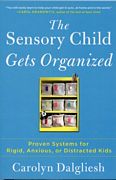
|
The Sensory Child Gets Organized:
Proven Systems for Rigid, Anxious, or Distracted Kids. Karen Dalgliesh, $18.99
Sensory Kids — like those with sensory
processing disorder, anxiety disorder, AD/HD, autism, bipolar disorder, and
OCD — often feel frustrated and overwhelmed, creating stress in everyday life for
the whole family. Now, with THE SENSORY CHILD GETS ORGANIZED, there’s help
and hope.
As a professional organizer and parent of a sensory child, Carolyn Dalgliesh
knows firsthand the struggles parents face in trying to bring out the best in
their rigid, anxious, or distracted children. She provides simple, effective
solutions that help these kids thrive at home and in their day-to-day
activities, and in this book you’ll learn how to:
- Understand what makes your sensory child tick
- Create harmonious spaces through sensory
organizing
- Use structure and routines to connect with your
child
- Prepare your child for social and school
experiences
- Make travel a successful and fun-filled journey
|
|
The Sensory Connection:
an OT and SLP Team Approach. Nancy Kashman & Janet Mora,
$21.95
Drawing on their extensive collective
experience in developing and implementing treatment programs for
use in home, school or clinical settings, Kashman and Mora provide
practical and workable strategies for helping children and adults
with sensory and communication disorders. |
Back to top
|
The Sensory Detective Curriculum Discovering Sensory
Processing and How It Supports Attention, Focus, and Regulation Skills. Paula
Aquilla, $33.50 
Understanding our sensory processing ability helps us to
understand our likes, dislikes, and regulation style; i.e., the strategies we
use to help keep ourselves in a calm, alert state. The calm, alert state is the
state necessary for learning! Knowing how to stay regulated is a life skill.
This ability enables us to function in different environments, in different
situations, and with different people.
The Sensory Detective Curriculum is a resource
that can be used in a school setting to enable children to learn more about
themselves and others. It meets learning goals in science and social studies
and can provide a platform to discuss how we behave and communicate with each
other. Opening this discussion can help us understand how tensions can rise,
how bullying can happen, and how children in our own classroom can feel lonely,
isolated and misunderstood. The Sensory Detective Curriculum enables
students to discover sensory processing and how it supports attention, focus
and regulation skills. Learning adventures include: the neurology of sensory
processing, how sensory processing supports the nervous system to pay attention
and focus, how emotion is connected to sensory processing and regulation. Each
chapter has fun activities for students to not only deepen their understanding
but to apply this understanding to their own classroom. |
|
Sensory
Integration and the Child: Understanding Hidden Sensory Challenges,
Revised 25th Anniversary Edition. Jean Ayres, revised and updated
by Pediatric Therapy Network $43.95
This classic handbook, from the originator
of sensory integration theory, is now available in an updated, parent-friendly
edition, retaining all the features that made the original edition
so popular with both parents and professionals. With a new foreword
by Dr. Florence Clark and commentaries by recognized experts in
sensory integration, this volume explains sensory integrative dysfunction,
how to recognize it, and what to do about it. Helpful tips, checklists,
question-and-answer sections, and parent resources make the new
edition more informative and useful. Indispensable reading for parents,
this book is also an excellent way to improve communication between
therapist, parents, and teachers. |
|
Sensory Integration:
a Guide for Preschool Teachers. Christy Isbell & Rebecca
Isbell, $25.95
SENSORY INTEGRATION: A GUIDE FOR
PRESCHOOL TEACHERS helps you identify children who have difficulties with
sensory processing, and it offers simple, easy-to-use solutions to support the
sensory needs of young children in the preschool classroom. Easy-to-implement
solutions include adaptations and activities for children with different types
of Sensory Processing Disorder. This book has a bonus chapter with instructions
for creating low-cost items to help children with sensory issues.
Chapters cover concepts such as:
- Explaining Sensory Integration and Sensory
Processing Disorder
- Defining sensory avoiders, seekers, and
under-responders
- Designing the environment to support the sensory
development of all children
- Helping preschoolers with sensory processing
problems
- Providing practical solutions to meet the needs
of individual children during daily routines
- Building and creating low-cost items such as a
tire swing, sand pillow, and incline board to give children opportunities to
get the sensory input they need
|
Back to top
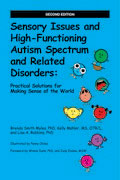
|
Sensory Issues and High-Functioning Autism Spectrum
and Related Disorders: Practical Solutions for Making Sense of the World. Brenda
Smith Myles, Kelly Mahler & Lisa Robbins, $30.95
Using the same product and easy-to-read format as the
first edition, this newly expanded book explains how many children with
high-functioning ASD relate to the world through their senses. The book reviews
sensory processing terminology and how the sensory systems impact
behavior. An expanded discussion of assessment tools is followed by a
comprehensive chapter on evidence-based interventions. Finally, a new
chapter looks at meeting a student's sensory needs throughout the day and
across environments using simple and easy-to-use forms and checklists. |
|
Sensory Issues for Adults with Autism Spectrum
Disorder. Diarmuid Heffernan, $23.95
Understanding sensory issues can be the key to overcoming
them. Using this practical guide, individuals with Autism Spectrum Disorders
(ASDs) can begin to understand their sensory difficulties and learn how to
create a tailored plan for overcoming specific everyday challenges.
Learn how the senses work and how sensory systems can
function differently for people with ASD, leading to sensory perceptual issues.
What are the difficulties that can arise at work, college, home, or in public
or cyberspaces? Practical strategies and creating a unique 'sensory plan',
based on frequently encountered environments and situations, will help any
adult with ASD to overcome these sensory difficulties. |
|
Sensory Issues in Learning &
Behavior DVD. Carol Kranowitz, $51.95 (Updated and
re-titled version of the DVD, “The Out-of-Sync Child”)
In this 3-hour DVD of a live
presentation, Carol Kranowitz offers sensory strategies and activities that are
applauded around the world. Carol discusses research in SPD and shares her 25
years of teaching experience. For every kind of sensory need, she has a story
that illustrates how a child may behave. She suggests techniques that work (and
some that don’t) and fun and functional activities that are sure to be a hit
with your young child or student, no matter what his or her sensory needs are.
Carol discusses recent research in SPD
by the world’s top investigators, the six types of SPD and how they can affect
the daily lives of children, possible co-existing problems (e.g., visual,
auditory, eating, sleeping, and emotional difficulties) and available treatment
and therapy options. |
Back to top
|
Sensory Like You: a Book for Kids With SPD By Adults
with SPD. Rachel Schneider & Kelly Dillon, $17.95
In this illustrated book for children ages six through
nine, SPD adult advocates Rachel and Kelly lead kids and their parents through
the basic ins-and-outs of what it means to have Sensory Processing
Disorders(SPD). |
|
Sensory Parenting
from Newborns to Toddlers. Britt Collins & Jackie
Linder Olson, $27.95
Sensory Parenting: the Elementary
Years. Britt Collins & Jackie Linder
Olson, $22.95
All of us have a sensory issue at one
time or another and most of us learn to adapt or to avoid the things that
irritate us without giving them a second thought. But for children with sensory
processing disorders, even the simplest daily activities can create anxiety and
stress that challenge the entire family’s ability to cope.
These two books offer a wealth of
information for parents of kids with sensory issues, loaded with tips and
solutions to manage everyday situations and get to the bottom of the
challenging behaviors, while helping parents to understand their child’s
sensory world. |
|
|
Sensory Perceptual Issues in Autism and Asperger
Syndrome. Olga Bogdashina, $33.95
Despite frequently being identified by individuals with
autism as one of the main problems they face, sensory perceptual issues are
still often overlooked by professionals. The author covers the sensory
perceptual experiences and sensitivities seen in autism spectrum conditions,
and the cognitive differences caused by them. She considers assessment and
intervention, and makes practical recommendations for selecting appropriate
methods and techniques to eliminate sensory perceptual problems and enhance individual
strengths.
Brought up-to-date with current research and the latest
thinking on autism, this book enables teachers, parents, professionals and
individuals with autism fully to understand and address the problematic aspects
of the sensory perceptual differences of people with autism spectrum
conditions. |
Back to top
|
Sensory Processing Challenges: Effective Clinical Work
with Kids & Teens. Lindsey Biel, $35.00
Many children and teens suffer from sensory challenges,
meaning that they have unusual reactions to certain sensory experiences that
most of us find commonplace. These challenges can range from moderate to
severe — from an aversion to bright lights or the feel of anything remotely
abrasive, to stopping short in panic every time a loud noise or siren is heard,
or having an oral tactile sensitivity that prevents normal feeling in the mouth
and hinders feeding. Accompanying these sensory issues — the full-blown version
of which is called “sensory processing disorder” (SPD) — can be a range of
behavioral problems like OCD and anxiety, and more severely, Asperger’s and
autism.
This book equips clinicians with all the information they need to know to
accurately identify sensory sensitivities in their child clients: how to pay
attention to sensory issues and recognize when a client is struggling; how
these issues factor into the behavioral problems at hand; and how best to
partner with the right professionals to help kids at home and in school. |
|
The
Sensory Processing Disorder Answer Book: Practical Answers to the
Top 250 Questions Parents Ask. Tara Delaney, $27.99
Written in a practical question and answer
format, The Sensory Processing Disorder Answer Book will
help parents, caregivers and educators understand SPD and how to
best help the child affected. |
Back to top
|
Sensory Stories for Children and Teens with Special
Educational Needs: a Practical Guide. Joanna Grace, $34.95
Sensory Stories are short stories of a few lines which
are brought to life through a selection of meaningful sensory experiences. They
are particularly beneficial for students with Sensory Processing Disorder
(SPD), profound and multiple learning difficulties (PMLD), autism spectrum
disorders (ASD) and other special educational needs (SEN). This accessible
guide offers teachers, other professionals working with students with SEN and
parents with a complete step-by-step guide to creating and using Sensory Stories
effectively. Aiming to make Sensory Stories affordable and accessible to
schools and parents alike by using everyday items found in the classroom and
home, Joanna Grace provides original, ready-to-use Sensory Stories with
accompanying lesson plans, games and activities and adaptations for different
abilities and diagnoses. |
|
The Sensory Team Handbook:
a Hands-On Tool to Help Young People Make Sense of Their
Senses. Nancy Mucklow, $28.95  |
The Sensory Team Handbook is the first book on sensory
processing written for pre-teens and young teens. Upbeat, humorous,
and hands-on, each chapter is stuffed with comics, cartoons, diagrams,
quizzes, trivia and question-answer sections. The handbook compares
the senses to a sports team in need of a coach and then shows the
reader how to become that coach. This unique sensory team approach
turns therapy into something kids can do by and for themselves.
Entirely jargon-free, and written in simple, everyday language, The
Sensory Team Handbook will inspire kids and teens to take charge
of their own sensory issues. |
|
|
Sensory Yoga for Kids: Therapeutic Movement for
Children of All Families. Britt Collins, $20.95
This book shows how to use yoga to bring calm and focus
(and exercise!) to kids with special needs.
Childhood is a time filled with new motor challenges and
hurdles; and this is doubly true for kids with autism and other special needs.
The motor challenges kids face require strength, coordination, and the ability
to focus and attend.
Yoga can help kids with these challenges as it can
strengthen their bodies while calming. This book demonstrates how to get kids
started with the discipline that so many of us use in our daily lives.
Occupational therapist Britt Collins tells how to use yoga to support special
needs, increasing body awareness and fine tune coordination skills. |
Back to top
|
The Sensory-Sensitive
Child. Karen A. Smith and Karen R. Gouze, $16.99
Practical solutions for out-of-bounds
behavior from practicing child psychologists who are also parents
of children with sensory integration problems. Learn strategies
to prevent problems, defuse crises, and help your child succeed
at home, and school and with friends. |
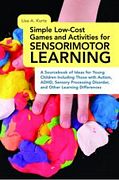
|
Simple Low-Cost Games and Activities for Sensorimotor
Learning: a Sourcebook of Ideas for Young Children Including Those with Autism,
ADHD, Sensory Processing Disorder, and Other Learning Differences. Lisa Kurtz,
$29.95
This practical sourcebook is packed full of fun, low-cost
games and activities that encourage the development of motor skills,
coordination and sensory tolerance in young children. Using materials that are
readily-available in most households or that can be purchased or homemade at a
very low cost, these games and activities are appropriate for all children,
including those with autism, ADHD, Sensory Processing Disorder, and other
learning challenges. The book includes clear descriptions of how to carry out
each activity, helpful illustrations, and ways to adapt activities according to
the child's individual needs. In addition, a comprehensive reference guide to
the activities enables easy searching for games suited to the development of
particular skills.
This sourcebook is the key to easy-to-understand,
low-cost, and effective games and activities that will support the development
of sensorimotor skills. It is a useful tool for parents, carers, therapists,
and teachers of children with or without special needs. |
|
So Loud it Hurts! Elaheh Bos, $19.95
Gus loves almost everything about his birthday. But when
the sounds become too loud, he feels overwhelmed and needs to remember what
silence feels like.
This book is a starting point to help children with sound
sensitivity take control of what is happening to them. |
Back to top
|
Sometimes Noise Is Big: Life with Autism. Angela
Coelho & Camille Robertson, $21.95 (ages 5+) 
What would life be like if the world was too noisy for
your eyes, or your clothes always felt too itchy? This picture book describes
the world from the point of view of a child with autism and the sensory issues
and big feelings they often encounter. This simple explanation is ideal for
children aged 5+ to help understanding of sensory issues. |
|
Songames for Sensory Processing: 25
Therapist Created Musical Activities for Improving Fine and Gross Motor Skills,
Muscle Strength, and Rhythmicity. Aubrey Lande, et
al, $28.50 (Book & 2 CD set)
Fun and engaging for kids ages 3-8,
SONGAMES are musical activities for improving fine-and gross-motor skills,
muscle strength, and rhythmicity. These 25 therapist-created SONGAMES offer a
world of developmental play activities. Plus, the 53-page companion booklet
explains how to use music to enhance specific skills, provides a comprehensive
list of resources, and triples the number of therapeutic ways to use the
games! |
|
Speak, Move, Play and Learn with
Children on the Autism Spectrum. Lois Jean Brady,
America Gonzalez, Maciej Zawadki & Corinda Presley, $34.95
Activities to boost communication
skills, sensory integration and coordination using simple ideas from speech and
language pathology and occupational therapy. |
Back to top
|
Starting Sensory Therapy:
Fun Activities for the Home or Classroom. Bonnie Arnwine, $22.95
STARTING SENSORY THERAPY offers 100+
activities and games for children with Sensory Processing Disorders (SPDs).
Parent of a son with SPD, author Bonnie Arnwine chose activities that require
minimal time, money, and clean-up. Most “ingredients” are already on hand:
empty yogurt cups, string, soap, Kool-aid, flour, paper plates, etc. If the
kids tire of an activity, an “Extend It!” section shows how to use the same
ingredients in new and different ways. Kids have fun while activities exercise
the seven sensory “muscles”: the visual, auditory, tactile, olfactory, oral,
vestibular, and proprioceptive senses. Activities can be enjoyed with others,
so children also benefit from interacting socially with their peers, parents,
and teachers. |
|
Stay Cool and In Control with the Keep-Calm Guru: Wise
Ways for Children to Regulate their Emotions and Senses. Lauren Brukner, illustrated
by Apsley, $24.95
Meet the Keep-Calm Guru, our expert guide to the art of
staying cool, calm, and in control in the face of overpowering feelings! This
illustrated book introduces wise ways for children to recognize and cope with
anxiety, anger, frustration, and other difficult emotions. Using everything
from yoga poses and pressure holds, to deep breathing and relaxing coloring
activities, the Keep-Calm Guru shows kids how to take back control and feel
cool, calm, and just right. Suitable for children with sensory and emotional
regulation difficulties aged approximately 7-14 years. |
|
Take Five! Staying ALERT at Home and School. Mary
Sue Williams & Sherry Shellenberger, $48.95
Take Five! is chock-full of fun activities
designed to support self-regulation in homes and schools. This book provides
simple, low-budget activities that support children to be alert and focused.
This book does not teach children about their engine
levels, but it is organized around the five ways to change how alert we feel,
covered in the Alert Program®. The chapters are titled the same as the five
ways to change how alert one feels (Mouth, Move, Touch, Look, and Listen
Categories). |
Back to top
|
A Teacher’s Guide to Sensory Processing Disorder CD. Carol Kranowitz & Stacey Sklut, $21.95
In this audio companion to the book, Answers to Questions Teachers Ask about Sensory Integration, Carol Kranowitz and Stacey Szklut discuss how to teach children with sensory processing problems. This 2-CD set offers help for teachers and other school professionals who are trying to reach kids with sensory difficulties and help them succeed in the classroom, and in life. |
|
Teaching the Moving
Child: OT Insights that Will Transform Your K-3 Classroom. Sybil
Berkey, $46.50
Because sensorimotor and environmental factors have a profound effect on children's learning, every teacher should know how to weave strategies from occupational therapy into their everyday instruction so all students can achieve their full potential.
A clear and reader-friendly guide from an OT with nearly 35 years of classroom experience, Teaching the Moving Child gives elementary educators the solid foundation of knowledge they need to:
- maximize the link between movement and learning
- meet the needs of students with sensory processing issues by modifying the classroom environment and task demands
- improve students' writing skills (includes an easy-to-use, five-step process for handwriting instruction)
- facilitate children's fine motor ability, including using pencils and scissors and drawing lines and shapes
- optimize learning through strategic use of classroom seating, space, lighting, and visual and auditory stimuli
- promote imaginative play as essential to every part of the learning process
- recognize and minimize students' stress, especially during transitions and waiting times
- decrease restlessness and increase attention through environmental planning strategies
- collaborate skillfully with OTs to address sensorimotor issues before they become a barrier to learning
|
|
Temple Talks about Autism and Sensory Issues: the
World's Leading Expert on Autism Shares Her Advice and Experiences. Temple
Grandin, $13.50
Have you even wanted to talk to Temple about the sensory
issues people with autism, Asperger’s, PDD and Sensory Processing Disorder deal
with? Here, in this handy reference book, Temple gives a overview of what it is
like to have autism and sensory difficulties, tells how she overcame her
sensory issues, gives useful tips, then answers your questions in an easy to
reference Q&A. |
Back to top
|
This Is Gabriel Making
Sense of School: a Book about Sensory Processing Disorder. Hartley
Steiner & Brandon Fall, $14.95
This delightfully illustrated picture
book provides insight into the challenges children with sensory issues face
every day. THIS IS GABRIEL gives readers a better understanding of our eight
senses, how they are affected, and what kinds of accommodations are necessary
to help children become learning sensations! |
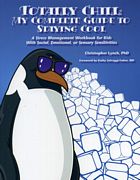
|
Totally Chill: My Complete Guide to
Staying Cool. Christopher Lynch, $29.95
A stress management workbook for kids
with social, emotional or sensory sensitivities. |
|
Too Loud, Too Bright, Too Fast, Too Tight: What to Do
If You Are a Sensory Defensive in an Overstimulating World. Sharon Heller,
$17.50
We all know what it feels like to be irritated by loud
music, accosted by lights that are too bright, or overwhelmed by a world that
moves too quickly. But millions of people suffer from Sensory Defensive
Disorder (SD), a common affliction in which people react to harmless stimuli
not just as a distracting hindrance, but a potentially dangerous threat.
Until now, the treatment for sensory defensiveness has
been successfully implemented in Learning Disabled children in whom
defensiveness tends to be extreme. However, the disorder has generally been
unidentified in adults who think they are either overstimulated, stressed, weird,
or crazy. These sensory defensive sufferers live out their lives stressed and
unhappy, never knowing why or what they can do about it. Now, with Too Loud,
Too Bright, Too Fast, Too Tight, they have a compassionate spokesperson and
a solution–oriented book of advice. |
Back to top
|
The Ultimate
Guide to Sensory Processing Disorder: Easy, Everyday Solutions to
Sensory Challenges. Roya Ostovar, $22.95
When sensory processing is impaired, lights can be too bright, sounds too loud and clothes too painful on the skin. It can be almost impossible for children to tolerate their day, let alone learn in a classroom.
Neuropsychologist Dr. Roya Ostovar helps parents and educators to understand and support children with Sensory Processing Disorder (SPD). She provides clear explanations, up-to-date research, step-by-step strategies and case examples that bring her methods to life. |
|
Understanding
Regulation Disorders of Sensory Processing in Children: Management
Strategies for Parents and Professionals. Pratibha Reebye
& Aileen Stalker, $25.95 
Children with regulation disorders of
sensory processing struggle to regulate their emotions and behaviors
in response to sensory stimulation. This book explains how to recognize
these disorders, which are often misdiagnosed, and offers practical
ways of helping children with regulation disorders.
The authors describe the everyday experiences
and distinguishing characteristics, symptoms, diagnosis, assessment
and treatment approaches for the disorder. Focusing on early intervention,
they present a range of management strategies for sensory sensitivities,
motor problems, over- or under-reaction, and extremes of behavior.
This concise book will be of interest to those who assess, educate
and parent children with regulation disorders. |
|
Understanding
Sensory Dysfunction: Learning Development and Sensory Dysfunction
in Autism Spectrum Disorders, ADHD, Learning Disabilities and Bipolar
Disorder. Polly Godwin Emmons & Liz McKendry Anderson, $23.95
Understanding Sensory Dysfunction
is a clear and comprehensive resource to identifying and addressing
sensory dysfunction in children, using a range of practical strategies
to help them reach their full potential at home, at school and in
the community.
The authors explain the causes, contributing
factors, symptoms and associated behaviors of sensory dysfunction,
particularly when found in conditions such as autism spectrum disorders
(ASDs), ADHD and bipolar disorder. Focusing on early intervention,
they provide a host of tried and tested integration activities,
assessment and curricular modifications, treatment options and useful
equipment and resources that ultimately aim to limit or prevent
the interference of sensory dysfunction with successful learning,
socialization and skills development. |
Back to top
|
Using
Intensive Interaction and Sensory Integration: a Handbook for
Those Who Support People with Severe Autism Spectrum Disorder.
Phoebe Caldwell, $25.95
People with severe autism experience
the sensory information they receive from the world completely differently
to those not on the spectrum. They feel cut off and overwhelmed,
and their behaviour can become very distressed. This handbook shows
how we can engage with people who are non-verbal or semi-verbal
and sometimes even those who have speech but lose the power to process
it when they are in crisis. We can help them to make sense of the
world. With illustrations, case examples and a wide range of tried-and-tested
techniques, this practical guide provides indispensable tools for
parents, caregivers and other professionals supporting people with
severe autism and other learning disabilities. |
|
|
The Weighted Blanket Guide: Everything You Need to
Know about Weighted Blankets and Deep Pressure for Autism, Chronic Pain, and
Other Conditions. Eileen Parker & Cara Koscinski, $21.95
Providing everything you need to know about the use of
weighted blankets to help with sensory integration, improve sleep, ease chronic
pain and more, this book includes:
- What a weighted blanket is and how it works
- An exploration of deep pressure and how weight on the
body affects the mind
- Guidelines for using weighted blankets at home and in
professional environments
- Studies into the effectiveness of weighted blankets
- Advice on how to select an appropriate weighted blanket
or sew your own.
Based on the latest research, this book dispels the
online myths surrounding weighted blankets. It delivers clear information for
occupational therapists and anyone considering using a weighted blanket to help
with sensory processing disorder, autism, sleep disorders, fibromyalgia,
post-traumatic stress disorder, and more. |
|
The Whole Spectrum of Social, Motor,
and Sensory Games: Using Every Child’s Natural Love of Play to Enhance Key
Skills and Promote Inclusion. Barbara Sher, $19.95
Play is increasingly recognized by
neuroscientists and educators as a vital component in brain development,
academic success and learning social skills. In this inspiring and useful
resource, Barbara Sher provides step-by-step directions for how to use
children's natural interests at different stages of their development to help them
develop a wealth of sensory-motor and social skills. All the games have also
been designed to provide plenty of joyful opportunities for encouraging
inclusion.
- Offers strategies for helping all kids, but
especially those with special needs, to develop social, motor and sensory
skills
- Filled with simple games using common materials
that can be used by teachers, parents, and caregivers with both individual kids
and groups
- Provides explanations and examples of how the
games can aid in a child's development
- Offers parents and teachers a fun and easy way
to include all children in activities that will engage all of their senses and
promote important skills
|
Back to top
|
Why Does Izzy
Cover Her Ears? Dealing with Sensory Overload. Jennifer Veenendall,
$25.95
Meet Izzy, a feisty first grader, whose behavior is often misunderstood
as she tries to cope with sensory overload in her new surroundings.
This brightly illustrated book creates an environment that is accepting
of students with sensory modulation difficulties, including many
on the autism spectrum. |
|
|
William Wobbly and the Very Bad Day, a Story about When
Feelings Become Too Big: a Therapeutic Parenting Book. Sarah Naish &
Rosie Jeffries, $17.95
William Wobbly lashes out and he doesn't know why. He
does things he doesn't mean to do and he always gets in trouble for it. But
luckily for William his mum understands that sometimes his feelings get too big
and muddled and burst out of him. This is the perfect story for any child who
struggles to manage their emotions. Something happened to William Wobbly when
he was very little which makes it hard for him to understand or control his
feelings. Luckily, his new mum is here to help with his wibbly wobbly feelings.
Written by a mum who understands, and her daughter (who
used to have a lot of wobbly feelings), this is a story for children
functioning at age 3-10 who struggle with sensory overload. |
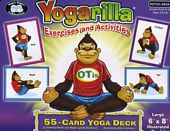
|
Yogarilla Exercises
and Activities: 55 Card Yoga Deck. Kimberly Mielke & Megan-Lynette
Richmond, $61.95 (ages 3 & up)
OTis, the OT gorilla, is here to teach children
traditional and original yoga poses in a new, fun, and engaging way!
The 55 yoga poses and 110 activities in
this oversized, colorfully illustrated card deck help children understand how
their bodies and minds work together. Occupational therapists, speech-language
pathologists, physical therapists, teachers, and parents can use yoga in the
classroom, at home, or in treatment to improve fine and gross motor skills,
sensory processing, attention, communication, and cognition. |
Back to top
Complete Booklist
Resources for Families &
Professionals
Active Imagination Activity Book. Kelly Tilley, $23.95
Answers to Questions Teachers Ask About Sensory
Integration: Forms, Checklists and Practical Tools. Carol Kranowitz et al,
$20.50
Ants in Their Pants: Teaching Children Who Must Move to
Learn. Aerial Cross, $41.50
Arnie and His School Tools: Simple Sensory Solutions That
Build Success. Jennifer Veenendall, $25.95
ASANAS for Autism and Special Needs: Yoga to Help
Children with Their Emotions, Self-Regulation and Body Awareness. Shawnee
Thornton Hardy, $19.95
The ASD and Me Picture Book: a Visual Guide to
Understanding Challenges and Strengths for Children On the Autism Spectrum.
Joel Shaul, $27.95
Autism and Everyday Executive Function: a Strengths-Based
Approach for Improving Attention, Memory, Organization, and Flexibility. Paula
Moraine, $30.95
Autism and the Stress Effect: a 4-Step Lifestyle Approach
to Transform Your Child's Health, Happiness and Vitality. Theresa Hamlin,
$22.95
A Buffet of Sensory Interventions: Solutions for Middle
and High School Students with Autism Spectrum Disorders. Susan Culp, $28.00
Building Bridges through Sensory Integration: Therapy for
Children with Autism and Other Pervasive Developmental Disorders, 3rd Edition.
Paula Aquilla, Shirley Sutton & Ellen Yack, $38.50
Building Sensory Friendly Classrooms to Support Children
with Challenging Behaviors. Rebecca Moyes, $28.00
Can I Tell You about Sensory Processing Difficulties? A
Guide for Friends, Family, and Professionals. Sue Allen, $15.95
Can't Play Won't Play: Simply Sizzling Ideas to Get the
Ball Rolling for Children with Dyspraxia. Sharon Drew & Elizabeth Atter, $27.95
Color My Senses: the Sensory Detective Coloring Book.
Paula Aquila, $13.50
Cool Bananas: Favorite Kids’ Rhythms for Calming, Cool
Downs and Bedtime Routines. Genevieve Jereb, $29.95
Creating Multi-sensory Environments: Practical Ideas for
Teaching and Learning. Christopher Davies, $42.50
Developmental Coordination Disorder: Hints and Tips for
the Activities of Daily Living. Morven Ball, $25.95
Back to top
Early Intervention Games. Barbara Sher, $19.95
Ellie Bean the Drama Queen. Jennie Harding, illustrated
by David Padgett, $13.50
Eurhythmics for Autism and Other Neurophysiologic
Diagnoses: a Sensorimotor Music-Based Treatment Approach. Dorita Berger, $35.95
Everyday Games for Sensory Processing Disorder: 100
Playful Activities to Empower Children with Sensory Differences. Barbara Sher,
$22.95 (for children ages 1-12)
Getting Kids in Sync DVD: Sensory-Motor Activities to
Help Children Develop Body Awareness and Integrate Their Senses. Carol
Kranowitz, $21.95 (29 minutes)
The Goodenoughs Get in Sync. Carol Stock Kranowitz,
Illustrated by T. J. Wylie, $16.95 (age 10 and up)
Growing an In-Sync Child: Simple, Fun Activities to Help
Every Child Develop, Learn and Grow. Cartol Kranowitz & Joye Newman, $20.00
A Guide to Sometimes Noise Is Big for Parents and
Educators. Angela Coelho & Lori Seeley, $19.95
Helping Your Child with Extreme Picky Eating: a
Step-by-Step Guide for Overcoming Selective Eating, Food Aversion, and Feeding
Disorders. Katja Rowell & Jenny McGlothlin, $24.95
How Does Your Engine Run? A Leader’s Guide to the Alert
Program for Self-Regulation. Mary Sue Williams & Sherry Shellenberger,
$60.95 (booklet, $13.95)
How to Be a Superhero Called Self-Control: Super Powers
to Help Younger Children to Regulate Their Emotions and Senses. Lauren Brukner,
illustrated by Apsley, $22.95
How to Help a Clumsy Child: Strategies for Young Children
with Developmental Motor Concerns. Lisa Kurtz, $15.95
I'll Tell You Why I Can't Wear Those Clothes! Talking
about Tactile Defensiveness. Noreen O'Sullivan, $17.95
Improving Sensory Processing in Traumatized Children:
Practical Ideas to Help Your Child's Movement, Coordination, and Body
Awareness. Sarah Lloyd, $19.95
Insights into Sensory Issues: Answers to Sensory
Challenges. Kathleen Morris, $21.50
The In-Sync Activity Card Book: 50 Simple Activities to
Help Children Develop, Learn, and Grow! Joye Newman & Carol Kranowitz,
$27.95
It's Haircut Time! Michele Griffin, $13.95
Jumpin’ Jelly Beans. Gen Jereb & Friends, $23.95 CD
The Kids' Guide to Staying Awesome and In Control: Simple
Stuff to Help Children Regulate their Emotions and Senses. Lauren Brukner,
Illustrated by Apsley, $25.95
Back to top
Learn to Have Fun with Your Senses: the Sensory Avoider’s
Survival Guide. John Taylor, $20.95
Learn to Move, Move to Learn! Sensorimotor Early
Childhood Activity Themes. Jenny Clark Brack, $48.50; DVD $37.95
Learning in Motion: 101+ Sensory Activities for the
Classroom. Patricia Angermeier, Joan Krzyzanowski & Kristina Keller Moir,
$53.95
Learning Though Movement and Active Play in the Early
Years: a Practical Resource for Professionals and Teachers. Tania Swift, $29.95
The Littlest Inventor. Mandi Mathis, $16.95
Living Sensationally: Understanding Your Senses. Winnie
Dunn, $24.95
Making Sense of Your Senses: a Workbook for Children with
Sensory Processing Disorder. Judy Christopher Auer & Michelle Auer, $23.95
A Moving Child Is a Learning Child: How the Body Teaches
the Brain to Think: Gill Connell, Cheryl McCarthy, $50.99 (Birth to Age 7)
Multisensory Rooms and Environments: Controlled Sensory
Experiences for People with Profound and Multiple Disabilities. Susan Fowler,
$69.95
My Sensory Book: Working Together to Explore Sensory
Issues and the Big Feelings They Can Cause: a Workbook for Parents,
Professionals, and Children. Lauren Kerstein, $24.50
No Longer a Secret. Doreit Bialer & Lucy Jane Miller,
$21.50
101 Activities for Kids in Tight Spaces. Carol Kranowitz,
$20.50
OT for Children with Autism, DVD. Britt Collins, $33.95
(DVD, 45 minutes)
The Out-of-Sync Child Grows Up: Coping with Sensory
Processing Disorder in the Adolescent and Young Adult Years. Carol Stock
Kranowitz, $23.00
The Out-of-Sync Child Has Fun: Activities for Kids with
Sensory Integration Dysfunction. Carol Kranowitz, $23.00
Out-of-Sync Child: Recognizing and Coping with Sensory
Processing Disorder. Carol Kranowitz, $22.00
Parenting a Child with Sensory Processing Disorder: a
Family Guide to Understanding & Supporting Your Sensory Sensitive Child.
Christopher Auer, $27.95
Picky, Picky Pete: a Boy and His Sensory Challenges.
Michele Griffin, $20.50
The Pocket Occupational Therapist for Families of Children
with Special Needs. Cara Koscinski, $25.95
Pocket Rocks. Sheree Fitch, illustrated by Helen Flook,
$10.95
Raising Kids with Sensory Processing Disorders: a
Week-by-Week Guide to Solving Everyday Sensory Issues. Rondalyn Whitney &
Varleisha Gibbs, $23.95
Raising a Sensory Smart Child: the Definitive Handbook
for Helping Your Child with Sensory Integration Issues, 2nd Edition. Lindsey
Biel & Nancy Peske, $24.00
Say G’Day: Sensory Integration through Rhythm and Song.
Genevieve Jereb, $29.95
Back to top
Self-Control to the Rescue: Super Powers to Help Kids
Through the Tough Stuff in Everyday Life. Lauren Brukner, illustrated by
Apsley, $22.95
Self-Reg: How to Help Your Child (and You) Break the
Stress Cycle and Successfully Engage with Life. Stuart Shanker, with Teresa
Barker, $20.00
Sensational Kids: Hope and Help for Children with Sensory
Processing Disorder. Lucy Jane Miller, $19.00
Sensing the City: an Autistic Perspective. Sandra
Beale-Ellis, $25.95
Sensitive Sam. Marla Roth-Fisch, $19.95 (ages 6-11)
Sensitive Sam Visits the Dentist. Marla Roth-Fisch,
$13.95
Sensorimotor Interventions: Using Movement to Improve
Overall Body Function. Cara Koscinski, $20.50
The Sensory Child Gets Organized: Proven Systems for
Rigid, Anxious, or Distracted Kids. Karen Dalgliesh, $18.99
The Sensory Connection: an OT and SLP Team Approach.
Nancy Kashman & Janet Mora, $20.95
The Sensory Detective Curriculum Discovering Sensory
Processing and How It Supports Attention, Focus, and Regulation Skills. Paula
Aquilla, $33.50
Sensory Integration: a Guide for Preschool Teachers.
Christy Isbell & Rebecca Isbell, $25.95
Sensory Integration and the Child: Understanding Hidden
Sensory Challenges, Revised 25th Anniversary Edition. Jean Ayres, revised and
updated by Pediatric Therapy Network $43.95
Sensory Issues for Adults with Autism Spectrum Disorder.
Diarmuid Heffernan, $23.95
Sensory Issues and High-Functioning Autism Spectrum and
Related Disorders: Practical Solutions for Making Sense of the World. Brenda
Smith Myles, Kelly Mahler & Lisa Robbins, $30.95
Sensory Issues in Learning & Behavior DVD. Carol
Kranowitz, $51.95 (Updated and re-titled version of the DVD, “The Out-of-Sync
Child”)
Sensory Like You: a Book for Kids With SPD By Adults with
SPD. Rachel Schneider & Kelly Dillon, $17.95
Sensory Parenting from Newborns to Toddlers. Britt
Collins & Jackie Linder Olson, $27.95
Sensory Parenting: the Elementary Years. Britt Collins
& Jackie Linder Olson, $22.95
Sensory Perceptual Issues in Autism and Asperger
Syndrome. Olga Bogdashina, $33.95
Sensory Processing Challenges: Effective Clinical Work
with Kids & Teens. Lindsey Biel, $35.00
The Sensory Processing Disorder Answer Book: Practical
Answers to the Top 250 Questions Parents Ask. Tara Delaney, $27.99
Sensory Stories for Children and Teens with Special
Educational Needs: a Practical Guide. Joanna Grace, $34.95
The Sensory Team Handbook: a Hands-On Tool to Help Young
People Make Sense of Their Senses. Nancy Mucklow, $28.95
Sensory Yoga for Kids: Therapeutic Movement for Children
of All Families. Britt Collins, $20.95
The Sensory-Sensitive Child: Practical Solutions for
Out-of-Bounds Behavior. Karen Smith & Karen Gouze, $16.99
Simple Low-Cost Games and Activities for Sensorimotor
Learning: a Sourcebook of Ideas for Young Children Including Those with Autism,
ADHD, Sensory Processing Disorder, and Other Learning Differences. Lisa Kurtz,
$29.95
So Loud it Hurts! Elaheh Bos, $19.95
Sometimes Noise is Big: Life with Autism. Angela Dunn,
$24.95
Songames for Sensory Processing. Aubrey Lande, et al,
$28.50 (Book & 2 CD set)
Speak, Move, Play and Learn with Children on the Autism
Spectrum. Lois Jean Brady, America Gonzalez, Maciej Zawadki & Corinda
Presley, $34.95
Starting Sensory Therapy: Fun Activities for the Home or
Classroom. Bonnie Arnwine, $22.95
Stay Cool and In Control with the Keep-Calm Guru: Wise
Ways for Children to Regulate their Emotions and Senses. Lauren Brukner,
illustrated by Apsley, $24.95
Back to top
Take Five! Staying ALERT at Home and School. Mary Sue
Williams & Sherry Shellenberger, $48.95
A Teacher’s Guide to Sensory Processing Disorder CD.
Carol Kranowitz & Stacey Sklut, $21.95
Teaching the Moving Child: OT Insights that Will
Transform Your K-3 Classroom. Sybil Berkey, $46.50
Temple Talks about Autism and Sensory Issues: the World's
Leading Expert on Autism Shares Her Advice and Experiences. Temple Grandin,
$13.50
This Is Gabriel Making Sense of School: a Book about
Sensory Processing Disorder. Hartley Steiner & Brandon Fall, $14.95
Too Loud, Too Bright, Too Fast, Too Tight: What to Do If
You Are a Sensory Defensive in an Overstimulating World. Sharon Heller, $17.50
Totally Chill: My Complete Guide to Staying Cool.
Christopher Lynch, $29.95
The Ultimate Guide to Sensory Processing Disorder: Easy,
Everyday Solutions to Sensory Challenges. Roya Ostovar, $22.95
Understanding Regulation Disorders of Sensory Processing
in Children: Management Strategies for Parents and Professionals. Pratibha Reebye
& Aileen Stalker, $25.95
Understanding Sensory Dysfunction: Learning Development
and Sensory Dysfunction in Autism Spectrum Disorders, ADHD, Learning
Disabilities and Bipolar Disorder. Polly Godwin Emmons & Liz McKendry
Anderson, $23.95
Using Intensive Interaction and Sensory Integration: a
Handbook for Those Who Support People with Severe Autism Spectrum Disorder.
Phoebe Caldwell, $25.95
The Weighted Blanket Guide: Everything You Need to Know
about Weighted Blankets and Deep Pressure for Autism, Chronic Pain, and Other
Conditions. Eileen Parker & Cara Koscinski, $21.95
The Whole Spectrum of Social, Motor, and Sensory Games:
Using Every Child’s Natural Love of Play to Enhance Key Skills and Promote
Inclusion. Barbara Sher, $19.95
Why Does Izzy Cover Her Ears? Dealing with Sensory
Overload. Jennifer Veenendall, $25.95
William Wobbly and the Very Bad Day, a Story about When
Feelings Become Too Big: a Therapeutic Parenting Book. Sarah Naish & Rosie
Jeffries, $17.95
Yogarilla Exercises and Activities: 55 Card Yoga Deck.
Kimberly Mielke & Megan-Lynette Richmond, $61.95 (ages 3 & up)
Back to top

Didn't
find it...?
Not sure...?
Need a suggestion...?
There are over 10,000 titles listed on our website and more than 35,000 titles in our inventory. If you haven't found what you want on the website — and it's one of our specialties — chances are good that we carry it, or can get it for you. Just let us know what you're looking for.
Call us toll-free 1-800-209-9182
or e-mail
PARENTBOOKS
is pleased to invoice institutions. Please inquire regarding terms and
discounts. Shop in person, by phone, fax, mail or e-mail . VISA, Mastercard
and Interac are welcome. We are open from 10:30 to 6:00 Monday through Friday and from 11:00 to 5:00 on Saturday.
 All prices are in Canadian dollars
and are subject to change without notice. All prices are in Canadian dollars
and are subject to change without notice.

|